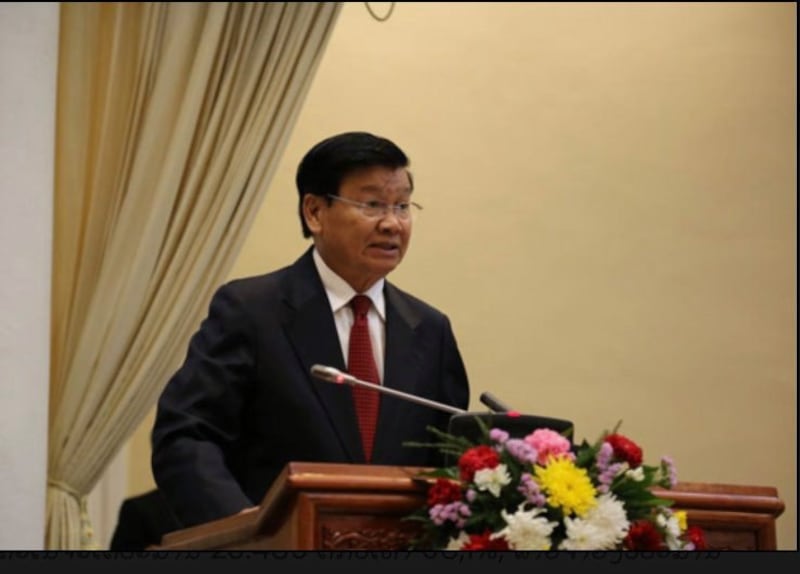Laos’ ruling party meets this week to select its top leadership to run the one-party communist state for five years, with some Laotians anticipating changes while experts say the elderly party brass could remain in place as the country tackles mounting debt and other deep-seated economic woes.
The landlocked country of 7.2 million people has been ruled since 1975 by the communist Lao People’s Revolutionary Party (LPRP), which monopolizes political power and control of the media, squashes all dissent, and retains tight fraternal party ties with Vietnam while deepening economic ties with China.
Meeting as the Lao economy reels from a year of the COVID-19 pandemic, the LPRP’s Jan 13-15 congress will select a general secretary, politburo party central committee and a politburo. The general secretary also serves as state president and will appoint a prime minister, to be rubber stamped by the Lao National Assembly.
In an opaque and secretive political system, predictions of the leadership line-up to be unveiled Friday vary among ordinary Laotians, ruling party members and foreign experts.
"Between the 13th and 15th of this month, the party congress will elect a new general secretary of the party and more than 70 members of the party central committee," a high-ranking official of the government told RFA's Lao Service.
“I’m expecting to see some new and young faces in the new leadership because most current leaders are old,” said a party member who, like the senior official, insisted on anonymity in order to speak freely.
A young woman in the capital told RFA “There will be a new party leader because many of the current leaders are of retirement age, between 60 and 65 years old. There must be some changes.”

‘He will move up’
General Secretary Bounnhang Vorachith is 83, while prime minister Thongloun Sisoulith, is 75.
Some Laotians in the capital Vientiane believe that the Vietnam-educated Bounnhang Vorachith will retire and vice-president Phankham Viphavanh, 70, will be chosen this week as party general secretary, then later as state president.
“Phankham Viphavanh will be the new party general secretary because he is clean,” said one. “He will move up.”
“Thongloun Sisoulith, the current prime minister, will serve another term of five years,” added the Vientiane resident. Thongloun is 75 and was educated in the Soviet Union.
Experts on Laos in next-door Thailand interviewed by RFA see things differently, with Bounnhang Vorachith remaining in power to serve a second term.
“The chances of Bounnhang stepping down are slim. His health is not bad and he is still needed by the party,” said Adisorn Semyam of the Asian Institute at Chulalongkorn University in Bangkok.
“It will depend on bargaining over power. If he stays at the top, Thongloun or Pany will be vice president,” he said, referring to Pany Yathotou, chairwoman of the Lao National Assembly.
Debt concerns
If Bounnhang Vorachith steps down, Thongloun will replace him at the top of the Party and government because as prime minister he is considered highly experienced, added Adisorn Semyam.
“If Thongloun becomes the party leader, another powerful politician, Sonexay Siphandone, a deputy prime minister and son of a former Party General Secretary Khamtai Siphandone, may take over the premiership, because he has been very active lately,” he said.
Yothin Sawaengdee of the Institute of Population and Social Research at Mahisol University in Bangkok says he thinks the new Lao leaders will lean toward traditional mentor Vietnam.
“The changes will be more positive and will improve the relationship with Vietnam. Vietnam will provide more assistance to Laos in terms of education, technology and especially access to ports or to the sea.”
Whoever emerges at the helm this week will have to steer Laos through recovery from the coronavirus pandemic -- which has devastated the country’s tourism and entertainment sectors and migrant labor remittances from Thailand – and deal with deep-seated economic troubles beginning with debt.
In 2020 the World Bank warned that Laos' debt -- most of it owed to China -- could hit 68 percent of GDP, while the U.S. ratings agency Moody's warned of a risk that Laos could default on its debts.
David Hutt, the Southeast Asia columnist at The Diplomat, writing in December, said the LPRP's rigid rejection of change in a political system built on "patronage and loyalty" made it difficult to implement broad tax system or state-owned industry reforms to cut debt levels.
“After a change of leadership at the communist party’s quinquennial National Congress early next year, we may see a slight shift in direction. But all indicators point to business as usual. Laos has backed itself into a corner and its political system limits the possible routes of escape.”
Washington-based Freedom House classified Laos as “not free” with a global freedom score of 14 out of 100 in its 2020 Freedom of the World survey, a score that ties Cuba and falls between China’s 10 and Vietnam’s 20.
Reported by RFA’s Lao Service. Translated by Max Avary. Written in English by Paul Eckert.
